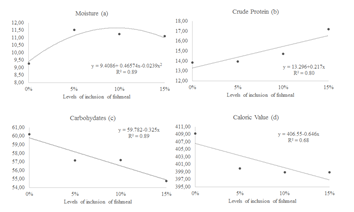Savory cereal bars made with seed, fruit peel, and fish meal
DOI:
https://doi.org/10.21708/avb.2020.14.4.9425Resumo
Cereal bars are practical, popular, and represent a multicomponent food with market potential. This work aimed to develop tasty cereal bars with kabocha seeds (Cucurbita moschata), kabocha peels, pineapple peel (Ananas sp.), and passion fruit peel (Passiflora sp.) with different levels of fishmeal, as nutritional enrichment. To this purpose, the fish meal was prepared with tilapia and salmon carcasses added to the basic ingredients of the bar. The fish concentrate levels used were 0% (control), 5%, 10% and 15%, amounting to four treatments, with five replications. The elaborated bars were analyzed for proximate compositional, sensory properties, and microbiological contamination. The results indicated high levels of protein (49.65%) and lipid (32.40%) for fishmeal. The inclusion of this concentrate in cereal bars interfered with their composition by increasing protein content and reducing the content of carbohydrates and caloric value. As for sensory properties, the average scores were around 6, which indicates that the panelists slightly liked the product. It can be concluded that the addition of up to 15% of tilapia fishmeal with salmon in savory cereal bars containing seed and fruit peel, improve their nutritional composition without adversely affecting their sensory quality.
Downloads

Downloads
Publicado
Edição
Seção
Licença
Autores que publicam na Acta Veterinaria Brasilica concordam com os seguintes termos: a) Autores mantém os direitos autorais e concedem à revista o direito de primeira publicação, com o trabalho simultaneamente licenciado sob a Licença Creative Commons Attribution que permite o compartilhamento do trabalho com reconhecimento da autoria e publicação inicial nesta revista. b) Autores têm autorização para assumir contratos adicionais separadamente, para distribuição não-exclusiva da versão do trabalho publicada nesta revista (ex.: publicar em repositório institucional ou como capítulo de livro), com reconhecimento de autoria e publicação inicial nesta revista. c) Autores têm permissão e são estimulados a publicar e distribuir seu trabalho online (ex.: em repositórios institucionais ou na sua página pessoal) a qualquer ponto antes ou durante o processo editorial, já que isso pode gerar alterações produtivas, bem como aumentar o impacto e a citação do trabalho publicado (Veja O Efeito do Acesso Livre).


 Esta obra está licenciada com uma Licença
Esta obra está licenciada com uma Licença 